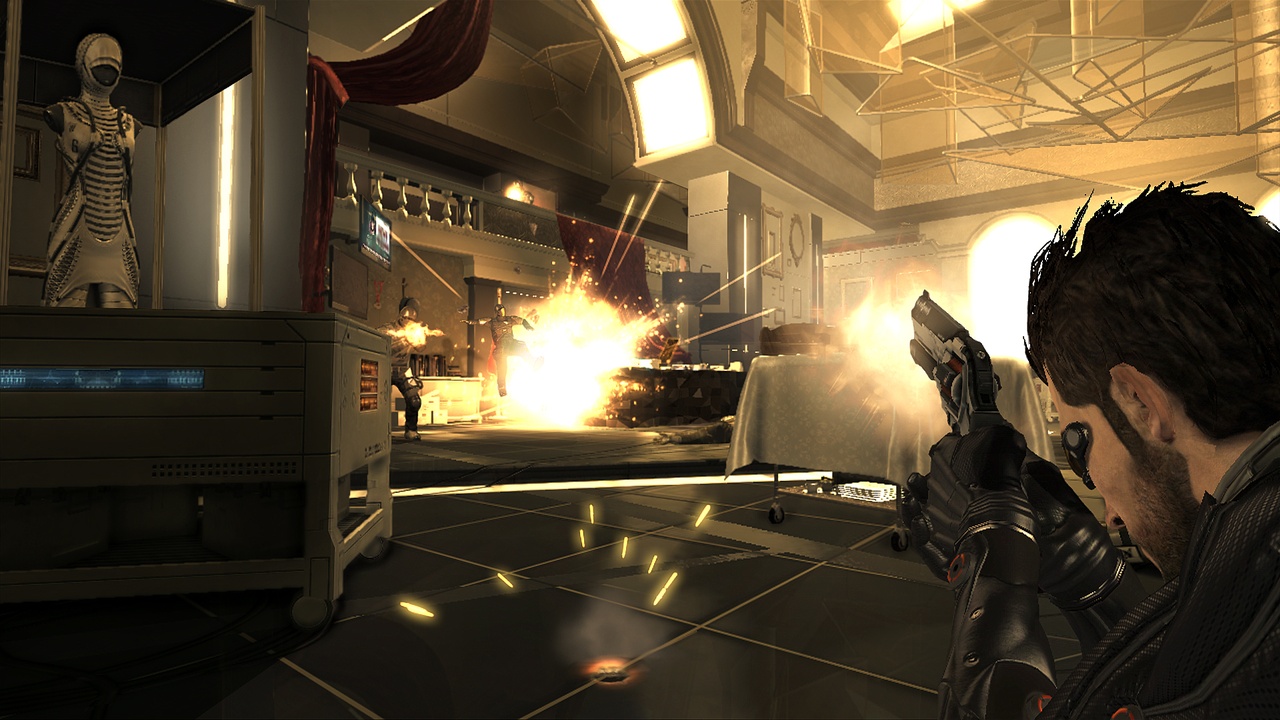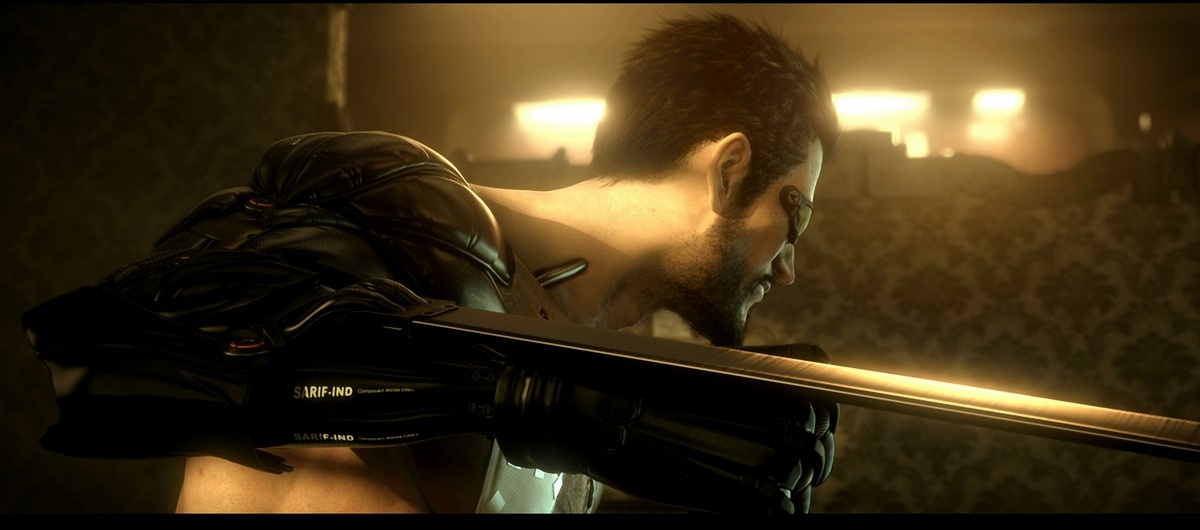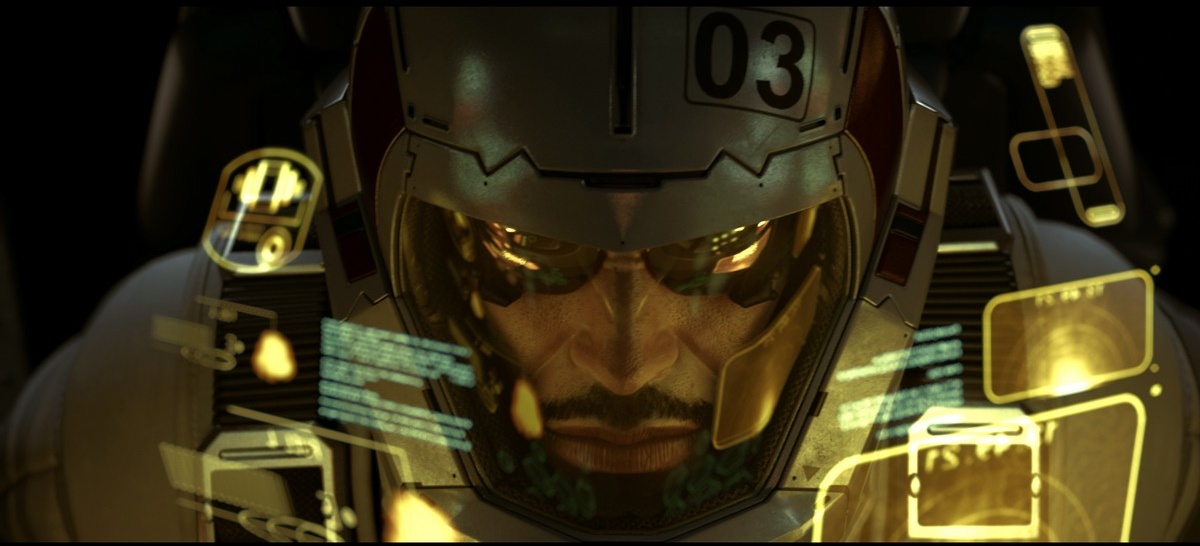Deus Ex: Human Revolution Hands-On Preview
We get our first hands-on with the third game in this fan favourite series and find out why robots are taking over.

Deus Ex: Human Revolution is a game that puts you in a robotic body (against your will) at a time when augmentation is still a taboo subject. Set as a prequel to the original Deus Ex, the game takes place in the year 2027, and you play as Adam Jensen, an ex-SWAT guy turned security guard for a biotech company.
We recently got our first hands-on time with an Xbox 360 version of the game, and since the game is filled with multiple paths and different choices, we thought it was worthwhile to give you our own experiences during our lengthy play session. We will warn you though, since our demo covers content in the first few hours of play, it comes with a healthy spoiler alert for those wanting to keep the opening part of the game a surprise. For backstory and more information on the franchise, check out our previous coverage of Human Revolution.
Our demo began in the office of biotech scientist Dr Reed, and it's clear from the outset that we have a history with her. Her demeanour conveys a certain level of urgency, and as she prepares to address the government on research she has been conducting, she suggests that we take a walk together. She explains that the room, and indeed Deus Ex's gameworld, is filled with e-mails, files, and newspaper articles to read, as well as TV bulletins that help explain much of what's going on. Almost counterproductively the game is also set against a clock of sorts, and by spending too much time trying to catch up on the news, you may inadvertently reduce your options or alter the way characters interact with you (there's no real way of knowing how your actions will affect outcomes, since there's no timer or bar to watch). In the same way, choosing one dialogue path over another may yield more information or shut down a conversation.

As you leave with the good doctor, both your conversations with her and the chatter from characters scattered around the building begin to indicate that the organisation you work for has its fingers in government military contracting pies. Needless to say, after this brief introduction to some of the key characters, things go pear-shaped when an emergency breaks out in the labs and Dr Reed drops off the grid. IT-turned-security-guy Pritchard attempts desperately to locate her, only to find that there is some form of abnormal signal causing interference. This early part of the game acts as a story primer and action introduction as you come to grips with gunplay and the game's slightly unorthodox cover mechanic--holding the left trigger to stick to cover and peeking out using the left analog stick. In what can only be described as a scene inspired by the Terminator film series, the screams of company workers are silenced as a huge robotic humanoid walks through flaming doorways; a piece of ballistics glass the only thing shielding him from the gunfire of your automatic weapon.
While developers on hand were keen to point out that you can play Deus Ex: HR as a modern Call of Duty-style shooter to some degree, it's not always the best approach (as anyone who has played a Deus Ex game knows). Taking the opportunity to try it out that way we encountered the need for careful surveillance, tracking the paths of enemy combatants and keeping an eye on which direction they were facing before sneaking in or breaching a room. Your approach to combat is as flexible as you want it to be. You can perch high, picking off attackers from raised walkways, take things down to their level to get personal, or blow out explosive canisters and gas lines to perform impromptu area-of-effect attacks MacGyver would be proud of.
Hot on the heels of the assailants, we barged into a hallway and came face-to-face with them. They weren't a friendly bunch, and the glint of neon lighting on cold steel was the last thing we saw as they pulled the trigger, loading up the game's intro credits. Six months later you're back at Sarif, sporting a spiffy new pair of sunglasses built into your head. This early in the augmentation process your parts clearly aren't all working as intended yet, and before we ship out on a critical mission we need to visit Pritchard to realign our retinal units. Again, there's the option to wander around, searching offices and climbing through the building's air-duct system in search of nooks and crannies to explore. Time is always a consideration though, and we're told to report to the helipad where the big cheese of the company is waiting to brief us.
Human Revolution continues the series trend of offering players the option to approach play in a variety of ways. The first decision we were presented with was the choice of either lethal or nonlethal engagement. The decision will have direct bearing on your loadout and will no doubt match your preferred play style and augmentation upgrades. Going nonlethal equips you with a stun gun, while selecting lethal grants the additional choice of either an up-close-and-personal revolver or a longer-range rifle. Since we knew we were infiltrating a factory, most likely with cramped corridors and hand-to-hand combat scenarios, we went for the pistol. Conscientious objectors in the crowd will be pleased to hear that (with the exception of a small handful of scripted boss encounters) the game can be played completely in stealth and doesn't require that you take any lives.
Our briefing included information that hostages were being held captive inside the plant; we were able to go on the secondary mission to locate and rescue them, or stay on the main storyline path and leave the hostages to their fate.
Once on the ground we were confronted by some of Jensen's former SWAT buddies who were clearly agitated at being asked to guard the exit rather than being allowed to bust in with guns blazing. Depending on whether or not stealth is your forte, each environment includes multiple points of entry and places to hide and observe. We took the low path, climbing down a ladder into a back alley, waiting for guards to patrol past alone before using our augmentation takedown moves. Each kill uses a bubble of energy and is performed by holding the B button. This generates a killing blow to nearby enemies, stabbing targets with blades that come flying out of your elbows. Unfortunately, while we assumed striking from behind with a blade would be a silent method of dispatching victims, on a few occasions enemies out of sight would be alerted by the sound of the thudding body, rushing to the scene to attack us. We're hoping this was just a symptom of the work-in-progress version of the game, and hopefully it will be fixed before the game ships.
Picking off foes one at a time and sneaking our way into a warehouse, we were presented with multiple hostiles in a small space. Rather than fight there, we shimmied our way up a ladder into some venting and quietly plopped down on some shelving. Unsurprisingly, firing our revolver had about as much subtlety as punching someone in the junk, and the AI scrambled to locate our position. Oddly, the hostiles seemed unable to look up, which left them sitting ducks, and we were able to them pick off at our leisure.
The game features Praxis Points, in-game currency that is used to upgrade and alter your augmentations at will. We were given six points for the purpose of testing out the skill trees, but normally you would have fewer than that. Unlocking a new ability, such as improved strength to lift heavy objects, requires two points, but each subsequent upgrade requires only one. Not all abilities are available on the first play-through, and the method of expenditure means that you will need to focus on improving key areas of skill rather than using a scattergun approach that sees you throwing points all over the place. Augmenting the limbs will reduce movement impairment when you take damage, while vision upgrades act a bit like Batman's Detective mode in Batman: Arkham Asylum, highlighting enemies on your screen and giving you the chance to plan your approach in advance.

Not all doors will be unlocked and waiting for your exploration, necessitating some crafty engineering. Hacking plays an integral role, and you'll be required to take part in a minigame where you select various nodes and attempt to gain entry to the data you need before you're traced by the system. The early minigames we saw were quite basic, though we can see the challenge escalating greatly further down the line, perhaps even requiring hacking augmentations that give you more time or make hacking easier to give you access to some restricted areas.
Our demo ended when we made it to one of the game's boss fights. Forget everything you thought you knew about boss fights with their glowing weak points and repeated patterns. Our final encounter involved one of the pro-human Purist revolutionaries holding a woman hostage. Our job was to end the situation, again with whatever outcome we felt appropriate. He kept his gun firmly pressed against her head, and we could have shot him, but in doing so we ran the risk of injury to the prisoner. Instead we went for the diplomatic route, navigating the treacherous waters of negotiation by first appealing to his base human emotions, throwing in a dash of flattery, and then ramming home the hard facts. Each dialogue option is spelt out clearly before you make your choice, so while there's very little room for crossed wires about choosing your approach, it did take some of the pressure and mystery away from the decision. After a brief verbal scuffle he released his victim, dashing out a nearby door. Our demo guide explained the various possible outcomes available and that as a result of saving her, the woman would appear further along the story to repay the favour, supplying valuable intelligence information.
Some minor quibbles and bugs aside, we enjoyed our first hands-on with Deus Ex: Human Revolution. The slightly unusual controls take a little rewiring of the old grey matter, but it becomes more natural as you continue to play. Fans of nonlinear story will have a field day replaying scenarios to find the points where the various subplots intertwine, and this certainly isn't a game that fans will be content to leave at a single play-through. Get ready for blade arms when Deus Ex: Human Revolution hits the Xbox 360, PlayStation 3, and PC on August 25 this year.
Marvel Rivals - Official Loki Character Reveal Trailer | The King of Yggsgard Remnant 2 - The Forgotten Kingdom | DLC Launch Trailer Stellar Blade - Official "The Journey: Part 2" Behind The Scenes Trailer | PS5 Games Fortnite Festival - Official Billie Eilish Cinematic Season 3 Trailer Dead by Daylight | Tome 19: Splendor | Reveal Trailer Starship Troopers: Extermination - Official "The New Vanguard" Update 0.7.0 Trailer Super Monkey Ball Banana Rumble - Official Multiplayer Features Trailer Nintendo 64 – April 2024 Game Updates – Nintendo Switch Online Gori: Cuddly Carnage | Meow Launch Date Announcement Trailer PUBG | Erangel Classic Returns Genshin Impact - "Arlecchino: Afterglow of Calamity" | Collected Miscellany Stellar Blade Review
Please enter your date of birth to view this video
By clicking 'enter', you agree to GameSpot's
Terms of Use and Privacy Policy
Got a news tip or want to contact us directly? Email news@gamespot.com

Join the conversation